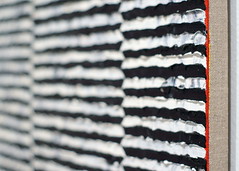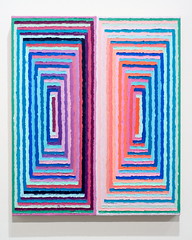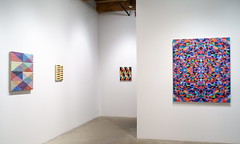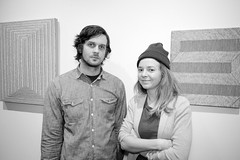
Above: Todd Chilton @ Rhona Hoffman, October 28 - December 3, 2011, edge detail

Above: Scott Stack @ Monique Meloche, October 15 – November 12, 2011, edge detail
In a previous article, on October 13, 2011, two days in advance of his exhibition at Monique Meloche Gallery, Scott Stack was recorded as follows: "'I'm not interested in pure green, or pure red, or anything straight out of the tube,' he said, 'That's not color.'"[1]
Whether his (Stack's) words were driven by prescience or exasperation, that formal antithesis which he conjured in speech was seen realized by Todd Chilton at Rhona Hoffman Gallery, on October 28, 2011.

Above: Todd Chilton @ Rhona Hoffman, October 28 - December 3, 2011, edge detail
In Chilton's presentation at Hoffman, more-or-less solid colors in alternation were used to build linear elements within paintings. Band-of-paint to band-of-paint, transitions were seen to be relatively abrupt and high in contrast; internal borders were well-defined, even if painterly. The periodic reversal of value and/or hue within said bands was, in aggregate, sometimes productive of a weak "gestalt effect," according to which geometric figures were able to be recognized.[2]

Above: Todd Chilton @ Rhona Hoffman, October 28 - December 3, 2011
In this regard, Chilton wholly depended upon his viewer's ability to psychologically complete his half-painted patterns: secondary shapes, however simple, e.g., diamond, needed to be known (knowable) in whole aforehand.
Conversely, in his most recent show at Meloche, Stack displayed a commitment to blending not only in his palette but also in the paint having been applied to the canvas. Movement from color-to-color and line-to-line within Stack's new paintings was usually characterized by a compact but gradual gradient progression; it was refined. Where Chilton's (impasto) surfaces were thick and tempestuous, Stack's surfaces were remarkably shallow and placid in spite of hours of brushwork.
It was in his composition that Stack roiled enigmatically, as the organization of his lines appeared stochastic, whether such activity was said to have some original correspondence to objective reality. Here, Stack was open as Rorschach to readings as yet unknown to himself or his audience.[3]
Above: Scott Stack, "Return of the Leopard Woman," 2009, oil on canvas, 89 x 74 inches, original image from Monique Meloche Gallery.
Stack is, roughly, twice Chilton's age; Stack must have held a brush for more than twice as many years as Chilton. And it's tempting to attribute at least some difference in their current work to said temporal disparity: What in youth seems clear, a matter of earnest to be vigorously pursued, frequently becomes a more complicated and ambiguous affair as the years pass. Why Chilton and Stack should have drawn relatively near one another, however briefly, now, is a yet more difficult thing to guess.
Historically, Scott Stack had seemed to be committed to the representation of abstractions--and not to representation or abstraction per se.[4] Painting the imagery reproduced by electronic devices, e.g., night vision equipment or television, Stack had spent years painting scenes already multiple generations distant from reality.[5][6] And it had been fairly easy to nestle him (Stack) in the near precedents set by Chicago Imagists: linking his apartment exteriors to Roger Brown, and his figure work to Ed Paschke.
Above: Scott Stack, "7:30pm Apartment," oil on canvas, 78 x 66 inches, original image from Monique Meloche Gallery.
Above: Scott Stack, "Queen," 2009, oil on canvas, 100 x 66 inches, original image from Monique Meloche Gallery.
Stack was a sort of surrealist with a conceptual bent, a foot in each local camp. But, Stack's more recent work recalls another continent almost one hundred years ago, in which time and place Cubism and Futurism were incubated. Maybe, Stack recalls Fernand Leger particularly.[7]
Above: Scott Stack, "Untitled," 2011, oil on canvas, 68 x 78 inches, original image from Monique Meloche Gallery.
Locally, Todd Chilton has been repeatedly associated with the purely formal issues of his craft.[8] And Chilton does indeed seem to be a painter of paintings: any reference external to the activity of himself, his viewer, and art history, appears limited if at all extant in his work. To the extent that Chilton is involved in a re-imagining of Op and Hard-Edge painting he too, like Stack, relies heavily upon abstractions which already exist somewhere in visual culture.

Above: Todd Chilton @ Rhona Hoffman, October 28 - December 3, 2011, installation view

Above: Todd Chilton @ Rhona Hoffman, October 28 - December 3, 2011, installation view
Not surprisingly, Chilton hails from one of the coastal states, and he's been picked-up and shown on the opposite coast. In spite of what happened in architecture and furniture design after pollination by the Bauhaus in the 1930s (and maybe in needful opposition to it) geometric abstraction in painting did not take root and flower in Chicago as it did in other places.[9] The easily imagined art historical precedents for Chilton and Stack's linear work, collected and exhibited in Chicago, tend to have been trucked-in from New York or some part of Western Europe. For example, Frank Stella and Barnett Newman hail from New York, Bridget Riley from England, and Sean Scully from Ireland.[10]
Maybe, playing upon the reference to the Weimar Republic in the preceding paragraph, Chilton and Stack are equally out of step with the "zeitgeist" in Chicago. Here and now, economic theory (Marx and Engels are only rarely named) underpins much contemporary education, production, and critique within the visual arts; and, not surprisingly, types of social art, poor art and street art constitute no small part of the local scene. Specialization in a particular craft, solitary studio work, and the production of real "commodities," such as the oil paintings on canvas made by Chilton and Stack, are things broadly considered to be passe.[11] For Scott Stack not to be connected to Todd Chilton's youthful cohort of SAIC and UIC graduates is a yet-more difficult thing. Whether Chilton will become more like Stack, or Stack more like Chilton, time will tell...
+ + +
Notes:
[1] http://paulgermanos.blogspot.com/2011/10/preview-scott-stack-monique-meloche.html
[2] http://en.wikipedia.org/wiki/Gestalt_psychology
[3] http://en.wikipedia.org/wiki/Hermann_Rorschach
[4] http://www.cod.edu/gallery/catalog/short_stack.pdf
Paragraph Two: "between representation and abstraction an approach to painting has developed that one might describe as 'situational,' a conceptually based attitude toward the application of paint,"
Above: Essay by Dominic Molon, past Pamela Alper Associate Curator, Museum of Contemporary Art, Chicago
"Situational Painting: Matthew Girson, Scott Short, Scott Stack"
May 19 - June 23, 2005
Gahlberg Gallery
College of DuPage
Glen Ellyn, Illinois
[5] Ibid.
Paragraph Six: "The skewed view of the world presented to us through electronic mediation is examined in the paintings of Scott Stack,"
Paragraph Six: "Stack’s depiction of scenes comprising shadowy forms often seen through some type of electronic distortion makes the more sinister implications of a life lived through televised, filmed or computer-based mediation (such as the use of media as a form of social control) visually manifest in his paintings,"
[6] http://articles.chicagotribune.com/2006-03-31/entertainment/0603310296_1_peter-miller-gallery-drawings-cover
"His first approach was to give contemporary scenes culled from newspaper photographs the look of having been viewed through night-vision goggles. So the images are horizontally striated..."
Above: Alan G. Artner, Chicago Tribune art critic, March 31, 2006, "Scott Stack at the Monique Meloche Gallery"
***Artner seems to suggest that Stack entered linear abstraction through the relatively straightforward representation of a technological distortion.***
[7] http://en.wikipedia.org/wiki/Fernand_Leger
Above: See "The Railway Crossing," 1919, noting stochastic arrangement of well-modeled diagonal lines.
See also: http://www.artic.edu/aic/collections/artwork/79600
[8] Todd Chilton appeared in both the 2006 and also 2010 iterations of the contemporary formal exhibition "Ps & Qs," as curated by Shannon Stratton and Jeff Ward.
2010: http://www.hydeparkart.org/exhibitions/ps-qs-1
Review: http://art.newcity.com/2010/03/22/review-ps-qshyde-park-art-center/
2006: http://microrevolt.org/reblog/archives/2006/09/ps-qs.html
Above: Todd Chilton, Nevin Tomlinson, Andrea Myers, Kirsten Flanigan, Mung Lar Lam, Paul Jackson, Carl Suddath, Katy Heinlein
September 8 - November 12, 2006
Glassell School of Art
Museum of Fine Arts, Houston
Todd Chilton appeared in both "Beautiful Form" and "New Formalisms 2" as curated by Abraham Ritchie, in 2009 and 2012 respectively.

Above: Todd Chilton with Samantha Bittman in "New Formalisms 2," on January 13, 2012, at 65GRAND, 1369 W. Grand Ave., Chicago, IL 60642
2012: http://65grand.com/newformalisms2_release.php
Review: http://art.newcity.com/2012/01/31/review-new-formalisms-2-65grand/
2009: http://www.65grand.com/beautiful_form_release.php
Review: http://art.newcity.com/2009/01/19/review-beautiful-form65-grand/
[9] http://en.wikipedia.org/wiki/Ludwig_Mies_van_der_Rohe
Above: See Illinois Institute of Technology, Second Chicago School, International Modernism, and Walter Gropius
[10] http://www.artic.edu/aic/collections/artwork/72177
Above: Sean Scully, "Heart of Darkness," 1982, oil on canvas, 96 x 144 inches
Scully was shown (and, if memory serves, afforded a great deal of space) at The Art Institute of Chicago, December 15, 1987 – February 7, 1988
[11] A Feminist critique of Chilton and Stack might additionally emphasize the artists maintenance of an essentially patriarchal narrative; the commercial, as opposed to domestic, context of the artists' exhibitions; the subordination and anonymity of familial support structures enabling each male artist; etc. Multiculturalists might find fault with Chilton and Stack when considering the narrow ethnic demographic which the two artists represent. Chicago Imagists, i.e., Surrealists, their collectors and chroniclers, not Marxists, Feminists, or multiculturalists, find little to love in any form of non-objective geometric abstraction. And, Neo-Conceptualists seem to occupy little intellectual ground apart from Marxism and Feminism.
+ + +
Exhibitions:
Todd Chilton
October 28 - December 3, 2011
Rhona Hoffman Gallery
118 North Peoria Street
Chicago, Illinois 60607
http://www.rhoffmangallery.com/
Scott Stack
October 15 – November 12, 2011
Monique Meloche Gallery
2154 W. Division
Chicago, Illinois 60622
http://moniquemeloche.com/
+ + +
Related Posts:
http://paulgermanos.blogspot.com/2011/07/editorial-after-minimalism-in-chicago.html
"Editorial: After Minimalism in Chicago the Summer of 2011," July 22, 2011
http://paulgermanos.blogspot.com/2010/09/review-todd-chilton-slow.html
"Review: Todd Chilton @ Slow," September 9, 2010
- Paul Germanos



